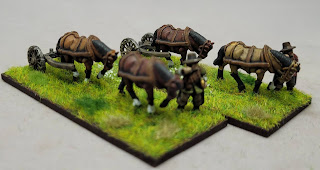Sir Charles Gerard’s Regiment of Foot
Another wargamer's favourite, on account of having an interesting flag. Their flag is often shown as blue and yellow, although the 'yellow' might more properly be a browny gold (Symonds described as 'fillemot' rather than 'or'). The flag also has a central laurel wreath design - the significance of this is unknown.
Fought at the siege of Manchester, Edgehill (where Gerard was badly wounded), present at the Turnham Green standoff before garrisoning Oxford. Took part in Rupert's storming of Cirencester, and possibly Birmingham too.
Gerard was wounded (again) at the siege of Lichfield. The Regiment besieged Reading, fought at First Newbury, and they were led at Cheriton by Lt Col Windebank; Gerard retaking command for a number of sieges and stormings (Kidwelly Casstle, Carmarthen, Cardigan, Newcastle Emlyn, Laugharne Castle, Roch Catle, Haverfordwest and Pembroke).
Late 1644 the Regiment was garrisoned at Bletchington House, once again under the command of Lt Col Windebank - which coincided with Gerard being wounded, yet again, this time at Newark.
Gerard was wounded (again) at the siege of Lichfield. The Regiment besieged Reading, fought at First Newbury, and they were led at Cheriton by Lt Col Windebank; Gerard retaking command for a number of sieges and stormings (Kidwelly Casstle, Carmarthen, Cardigan, Newcastle Emlyn, Laugharne Castle, Roch Catle, Haverfordwest and Pembroke).
Late 1644 the Regiment was garrisoned at Bletchington House, once again under the command of Lt Col Windebank - which coincided with Gerard being wounded, yet again, this time at Newark.
 |
| Painted by Alan Tuckey, basing by my own fair hand |
Gerard accompanied the King on his last marches of 1645 as a brigade commander and fought at Rowton Heath. He remained loyal to Prince Rupert during the Prince's court-martial at Newark in October 1645, during which he denounced Rupert's enemy Lord Digby as a traitor. Gerard was dismissed from the King's service along with other officers loyal to Rupert. He was pardoned early in 1646 and fought in the final siege of Oxford in June 1646 after which he went abroad with Prince Rupert and Prince Maurice.
Gerard was frequently engaged in plots against Cromwell; his cousin Colonel John Gerard was executed in July 1654 for his involvement in one of these plots. Gerard also served in the French army and would go on to command a troop of cavalry in Charles II's Royalist army in Flanders during 1657-8.
When Charles II entered London at the Restoration in 1660, Gerard rode at the head of the King's Horse Guards. Promoted to the earldom of Macclesfield in 1679. Accused of involvement in Monmouth's Rebellion he had to flee the country to avoid arrest.
He returned at the head of the King's Lifeguard in 1688 with William of Orange in 1688.
He died in January 1694 and is buried in Westminster Abbey.
He died in January 1694 and is buried in Westminster Abbey.
If you enjoyed reading this, or any of the other posts, please consider supporting the blog.
Thanks.












Lovely... liked the regiment o much I painted them twice.. two scales.. :o)
ReplyDeleteThanks. That way madness lies!
DeleteWhat an amazing career Gerard had; great background KYPD.
ReplyDeleteThanks Codsticker.
DeleteWhat an interesting career Gerard had. Thanks Radar.
ReplyDeleteThanks nundanket.
DeleteFor interest, the Regiment of Charles Gerard has been recreated in the English Civil war re-enactment society the Sealed Knot, https://www.thesealedknot.org.uk/ and frequently can be seen on the battlefield at various locations around the UK.
ReplyDeleteGraham Matthews, Sergeant, Charles Gerard regiment of foot, musket block
Thank you Graham
Delete